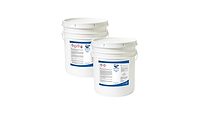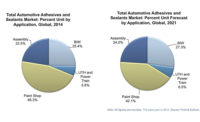Global Methyl Methacrylate Adhesives Market on the Move as Transportation Demands Increase
The composites sub-segment is expected to be the fastest-growing substrate in the global MMA adhesives market.

The global methyl methacrylate (MMA) adhesives market was valued at approximately $10.6 billion in 2018 and is projected to cross $13.5 billion by 2024, growing at a CAGR of 4.3%, according to a recent market study by TechSci Research. Growing demand from the transportation industry in emerging countries, as well as rising inclinations toward low carbon-emitting vehicles, are leading to growing consumption of MMA adhesives. However, volatility of raw materials pricing is hindering market growth.
Among derivatives, poly methyl methacrylate (PMMA) is the leading segment, as MMA is mainly used as a raw material for PMMA. In huge demand in the automotive, construction, and electronics industries, PMMA is mostly used as an alternative to glass in automotive and construction. The use of MMA adhesives in the automotive industry is growing rapidly, since they minimize the weight of vehicles and provide superior performance characteristics. These adhesives are used in the automotive components, as well as in the exteriors and interiors of automobiles.
On basis of substrates, metal is the largest segment and is anticipated to dominate the market in the coming years. However, the composites sub-segment is expected to be the fastest-growing substrate in the global MMA adhesives market due to rising demand for bonding composite components (including bumpers, deflectors, roofs, blades, composite tanks, car seats, interior body panel structures, and instrument panels).
Regionally, Asia-Pacific is the leading segment in the global MMA adhesives market. The region is also the major producer of MMA adhesives. Due to economic shrinkage and saturation in both European and North American markets, the demand is shifting to Asia-Pacific. The region has emerged as one of the leading producers and consumers of MMA adhesives due to rising income levels and increasing domestic demand, as well as easy access to resources.
Additional details are available at www.techsciresearch.com.
Looking for a reprint of this article?
From high-res PDFs to custom plaques, order your copy today!




